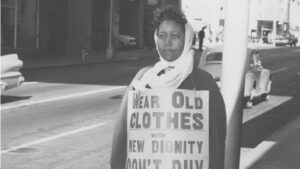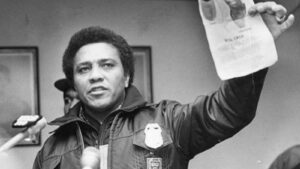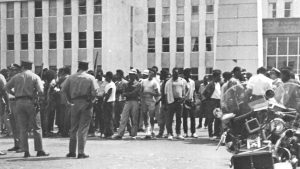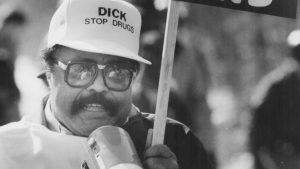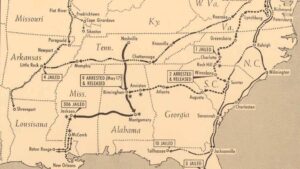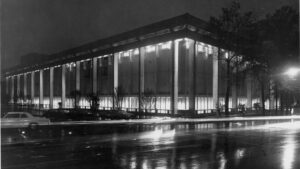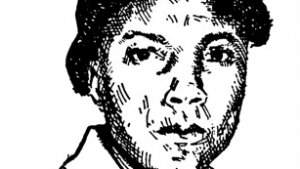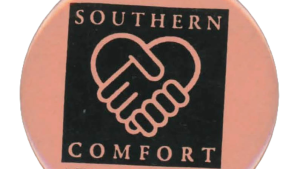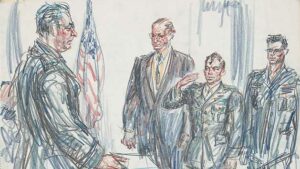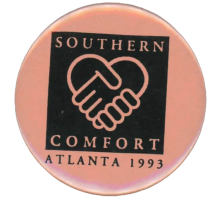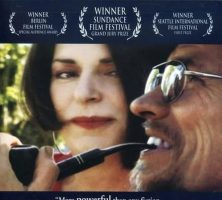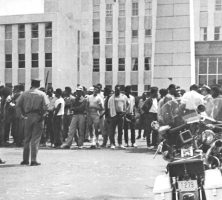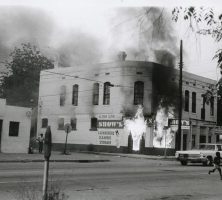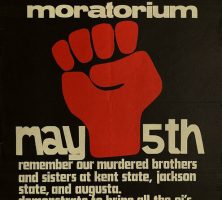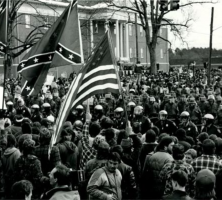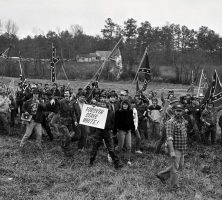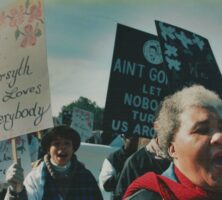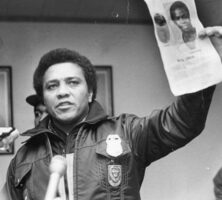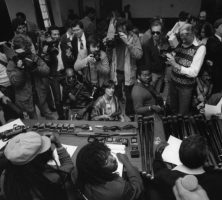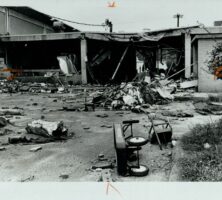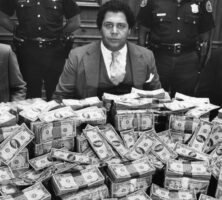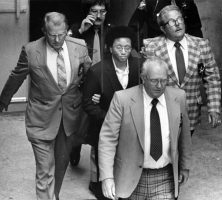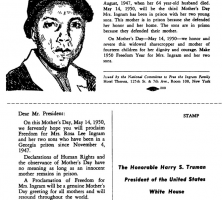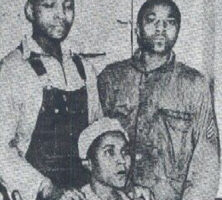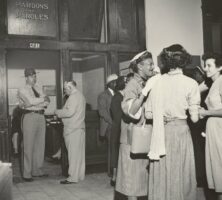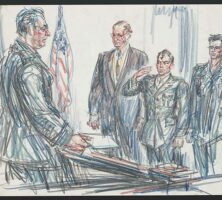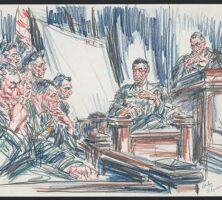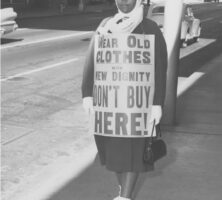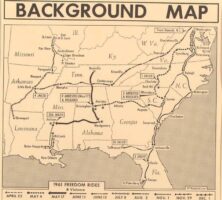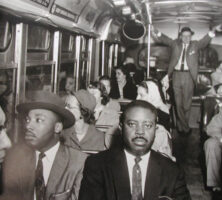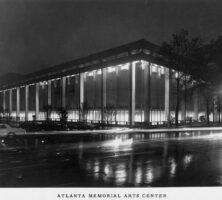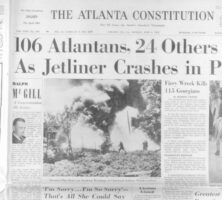The New Georgia Encyclopedia is supported by funding from A More Perfect Union, a special initiative of the National Endowment for the Humanities.
The Southern Comfort Conference was one of the most well-known transgender conferences in the United States. Originally held in Atlanta, it created a space where members of the transgender community could gather, learn about medical resources, and organize politically.
From the Digital Transgender Archive, Joseph A Labadie Collection, University of Michigan.
The New Georgia Encyclopedia does not hold the copyright for this media resource and can neither grant nor deny permission to republish or reproduce the image online or in print. All requests for permission to publish or reproduce the resource must be submitted to the rights holder.
The 2001 documentary Southern Comfort brought unprecedented attention and visibility to the Southern Comfort Conference. Directed by Kate Davis, the film follows the final months of long-time conference regular Robert Eads, a Georgian transgender man dying of ovarian cancer.
The New Georgia Encyclopedia does not hold the copyright for this media resource and can neither grant nor deny permission to republish or reproduce the image online or in print. All requests for permission to publish or reproduce the resource must be submitted to the rights holder.
On May 11, 1970 protestors massed outside an Augusta municipal building to protest the killing of Charles Oatman, a developmentally disabled Black teenager, in the Richmond County Jail. In 2021 the Department of Justice, through its Cold Case initiative, reopened its investigation into the deaths of Oatman and six other Black Augustans killed in the ensuing protests.
From Reese Library Augusta University
The New Georgia Encyclopedia does not hold the copyright for this media resource and can neither grant nor deny permission to republish or reproduce the image online or in print. All requests for permission to publish or reproduce the resource must be submitted to the rights holder.
On May 11, 1970 thousands of Black Augustans participated in a major uprising against police violence. Known thereafter as the Augusta Riot, the event resulted in $1 million in property damage and was the largest Black rebellion in the civil rights South.
From the Augusta Chronicle
The New Georgia Encyclopedia does not hold the copyright for this media resource and can neither grant nor deny permission to republish or reproduce the image online or in print. All requests for permission to publish or reproduce the resource must be submitted to the rights holder.
On May 5, 1971 students held a national moratorium to remember the deaths of protestors at Kent State University, Jackson State University, and in Augusta the previous spring. In the years that followed, Kent State remained a national touchstone for repressive violence, while Black rebellions in Augusta, Jackson, and elsewhere receded from national memory.
From the Student Mobilization Committee to End the War in Vietnam
The New Georgia Encyclopedia does not hold the copyright for this media resource and can neither grant nor deny permission to republish or reproduce the image online or in print. All requests for permission to publish or reproduce the resource must be submitted to the rights holder.
Organized by civil rights activists Dean Carter, Charles Blackburn, and Hosea Williams, the Brotherhood March brought nationwide attention to Forsyth County's long history of racial violence and discrimination.
Courtesy of Atlanta History Center, Southline Press, Inc. Photographs, #VIS 158.18.05.
The New Georgia Encyclopedia does not hold the copyright for this media resource and can neither grant nor deny permission to republish or reproduce the image online or in print. Requests for permission to publish or reproduce the resource should be submitted to the Atlanta History Center.
White supremacists picketing at the first Brotherhood March on January 17, 1987, in Forsyth County.
Courtesy of Atlanta Journal-Constitution, Atlanta Journal-Constitution Photographic Archive, #AJCNS1987-01-17l.
The New Georgia Encyclopedia does not hold the copyright for this media resource and can neither grant nor deny permission to republish or reproduce the image online or in print. All requests for permission to publish or reproduce the resource must be submitted to the Atlanta Journal-Constitution.
Marchers demonstrate for fair housing in Forsyth County in 1987. The march, led by Hosea Williams, ended in a confrontation with Ku Klux Klansmen throwing rocks and bottles at the demonstrators. The incident brought national attention to Forsyth County and resulted in the indictment of two Klan organizations.
Courtesy of Atlanta Journal-Constitution.
The New Georgia Encyclopedia does not hold the copyright for this media resource and can neither grant nor deny permission to republish or reproduce the image online or in print. All requests for permission to publish or reproduce the resource must be submitted to the Atlanta Journal-Constitution.
Hosea Williams led two demonstration marches in Forsyth County in 1987. The first march, held in celebration of the Martin Luther King Jr. holiday, was attacked by several hundred members of the Ku Klux Klan. The second march, attended by Coretta Scott King, was held in protest of Klan activities in the county.
Courtesy of Atlanta Journal-Constitution.
The New Georgia Encyclopedia does not hold the copyright for this media resource and can neither grant nor deny permission to republish or reproduce the image online or in print. All requests for permission to publish or reproduce the resource must be submitted to the Atlanta Journal-Constitution.
At a press conference, Assistant Police Chief Eldrin Bell holds up a photo of one of the victims of the Atlanta youth murders. From 1979 through 1981, at least twenty-nine Atlantans between the ages of seven and twenty-seven were abducted and slain.
Courtesy of Special Collections & Archives, Georgia State University Library, Atlanta Journal-Constitution Photographic Archive.
The New Georgia Encyclopedia does not hold the copyright for this media resource and can neither grant nor deny permission to republish or reproduce the image online or in print. Requests for permission to publish or reproduce the resource should be submitted to Special Collections and Archives at Georgia State University.
During the Atlanta youth murders, Techwood Homes community members formed a neighborhood "Bat Patrol." By the time city officials established a formal task force to investigate the killings, eleven young Atlantas had already been added to the list of missing and murdered.
Courtesy of Special Collections & Archives, Georgia State University Library, Atlanta Journal-Constitution Photographic Archive.
The New Georgia Encyclopedia does not hold the copyright for this media resource and can neither grant nor deny permission to republish or reproduce the image online or in print. Requests for permission to publish or reproduce the resource should be submitted to Special Collections and Archives at Georgia State University.
The remains of the Gate City Day Nursery after an explosion on October 29, 1980, that claimed the lives of five people, including four Black children. Though the blast was attributed to an overheated boiler, many community members and observers remained unconvinced that it was an accident.
Courtesy of Special Collections & Archives, Georgia State University Library, Atlanta Journal-Constitution Photographic Archive.
The New Georgia Encyclopedia does not hold the copyright for this media resource and can neither grant nor deny permission to republish or reproduce the image online or in print. Requests for permission to publish or reproduce the resource should be submitted to Special Collections and Archives at Georgia State University.
From July 1979 through May 1981 the Atlanta child murders took place. With leads in the case dwindling and no arrest in sight, Atlanta mayor Maynard Jackson imposed a 7:00 p.m. curfew on the city's children and offered a $10,000 reward (pictured) for information about the perpetrator of the crimes.
Courtesy of Atlanta Journal-Constitution.
The New Georgia Encyclopedia does not hold the copyright for this media resource and can neither grant nor deny permission to republish or reproduce the image online or in print. All requests for permission to publish or reproduce the resource must be submitted to the Atlanta Journal-Constitution.
Atlanta youth murders suspect Wayne Williams is escorted back to Fulton County Jail after a hearing in 1981. Williams would eventually be convicted of two murders and implicated in virtually all of the others.
Courtesy of Special Collections & Archives, Georgia State University Library, Atlanta Journal-Constitution Photographic Archive.
The New Georgia Encyclopedia does not hold the copyright for this media resource and can neither grant nor deny permission to republish or reproduce the image online or in print. Requests for permission to publish or reproduce the resource should be submitted to Special Collections and Archives at Georgia State University.
The National Committee to Free the Ingram Family worked to promote public interest in Rosa Lee Ingram's case. Their efforts included this Mother's Day postcard campaign addressed to President Truman.
Image by the National Committee to Free the Ingram Family, Wikimedia
The New Georgia Encyclopedia does not hold the copyright for this media resource and can neither grant nor deny permission to republish or reproduce the image online or in print. All requests for permission to publish or reproduce the resource must be submitted to the rights holder.
Rosa Lee Ingram and two of her adolescent sons were sentenced to death for their role in the death of a white landowner in 1948. Their conviction raised considerable doubt about the integrity of Georgia's judicial system and prompted a nationwide campaign to secure their release from prison.
Photograph from BlackPast.org
The New Georgia Encyclopedia does not hold the copyright for this media resource and can neither grant nor deny permission to republish or reproduce the image online or in print. All requests for permission to publish or reproduce the resource must be submitted to the rights holder.
Supporters of Rosa Lee Ingram wait outside the offices of the Georgia State Board of Pardons and Paroles during her 1953 parole hearing. The Ingrams were denied parole several times before their release from prison in 1959.
Photograph by Norma Holt, from the Schomburg Center for Research in Black Culture, Photographs and Prints Division, New York Public Library
The New Georgia Encyclopedia does not hold the copyright for this media resource and can neither grant nor deny permission to republish or reproduce the image online or in print. All requests for permission to publish or reproduce the resource must be submitted to the rights holder.
William Calley Jr., depicted here in an artist rendering of his 1971 court-martial, was the only U.S. soldier convincted for his role in the My Lai Massacre.
Courtesy of Library of Congress, Prints and Photographs Division, Sketch by Howard Brodie.
The New Georgia Encyclopedia does not hold the copyright for this media resource and can neither grant nor deny permission to republish or reproduce the image online or in print. All requests for permission to publish or reproduce the resource must be submitted to the rights holder.
Captain Ernest L. Medina testifies during the 1971 trial of Lieutenant William Calley Jr. The army Peers Commission concluded that Calley's platoon was responsible for roughly one-third of the deaths at My Lai, and Calley was found guilty on twenty-two counts of premeditated murder. . troops killed hundreds of unarmed civilians in a small coastal village inQiang Ngai province, South Vietnam
Courtesy of Library of Congress, Prints and Photographs Division, Sketch by Howard Brodie.
The New Georgia Encyclopedia does not hold the copyright for this media resource and can neither grant nor deny permission to republish or reproduce the image online or in print. All requests for permission to publish or reproduce the resource must be submitted to the rights holder.
A woman wearing a sign protesting segregated facilities outside of Rich's department store in downtown Atlanta, Georgia. The sign says "Wear Old Clothes with New Dignity. Don't Buy Here"
Courtesy of Atlanta History Center.
The New Georgia Encyclopedia does not hold the copyright for this media resource and can neither grant nor deny permission to republish or reproduce the image online or in print. Requests for permission to publish or reproduce the resource should be submitted to the Atlanta History Center.
This map shows the routes of numerous Freedom Rides that took place throughout the South from April through December 1961. The rides were intended to test compliance with federal court rulings barring segregation in interstate travel. Freedom Rides were a successful tool in advancing the cause of civil rights.
Map by Associated Press Newsfeatures
The New Georgia Encyclopedia does not hold the copyright for this media resource and can neither grant nor deny permission to republish or reproduce the image online or in print. All requests for permission to publish or reproduce the resource must be submitted to the rights holder.
Ralph David Abernathy (right) and Martin Luther King Jr. were central organizers of the Montgomery bus boycott, which demanded that Black passengers be treated fairly on public transportation.
Courtesy of David Fankhauser
The New Georgia Encyclopedia does not hold the copyright for this media resource and can neither grant nor deny permission to republish or reproduce the image online or in print. All requests for permission to publish or reproduce the resource must be submitted to the rights holder.
The Atlanta Memorial Arts Center opened in 1968. It stands as a memorial to the Atlanta Art Association members who died in the Orly air crash.
Courtesy of Atlanta History Center.
The New Georgia Encyclopedia does not hold the copyright for this media resource and can neither grant nor deny permission to republish or reproduce the image online or in print. Requests for permission to publish or reproduce the resource should be submitted to the Atlanta History Center.
News of the Orly tragedy made the front page of the Atlanta Constitution, June 4, 1962.
Courtesy of Atlanta History Center.
The New Georgia Encyclopedia does not hold the copyright for this media resource and can neither grant nor deny permission to republish or reproduce the image online or in print. Requests for permission to publish or reproduce the resource should be submitted to the Atlanta History Center.
